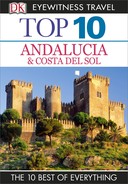The Sierra Nevada
The Sierra Nevada (“Snowy Mountains”) include Spain’s tallest peaks and are Europe’s second-highest mountain range after the Alps. Until the 20th century, their only regular visitors were the so-called neveros (“icemen”), who brought back blocks of ice to sell in nearby Granada, and for many years the only part they played in a tour of the region was as the glistening backdrop to the Alhambra Palace. They are now regularly visited and have become more and more popular in their own right – for trekking, skiing and exploring the remarkable collection of villages on their southern slopes, Las Alpujarras.![]() Parque Nacional de la Sierra Nevada • Ctra Antigua de Sierra Nevada, km 7 • 958 02 63 00 • www.magrama.gob.es/es/red-parques-nacionales/ (in Spanish)
Parque Nacional de la Sierra Nevada • Ctra Antigua de Sierra Nevada, km 7 • 958 02 63 00 • www.magrama.gob.es/es/red-parques-nacionales/ (in Spanish)
1. Setting
This mountain chain and its national park are home to Spain’s highest peak, Mulhacén (3,482 m/11,425 ft) at the western end and fertile valleys to the south.
2. Flora & Fauna
Snow-capped most of the year, these heights are nevertheless rich in wildflowers. Some 60 varieties are unique here, including a giant honeysuckle. The ibex is the most common species of fauna, but there are also butterflies, and birds such as the golden eagle.
3. Hiking
There is a paved road over the top of the range but the uppermost reaches have been closed to cars since the national park was established in 1999. In summer it’s a hiker’s paradise – the second highest peak Veleta (3470 m/ 11,385 ft) is a relatively easy 5-hour roundtrip.
4. Skiing
The main ski resort, Solynieve, is Europe’s highest and most southerly, in operation from December to April or even May. The pistes and facilities are good enough to have hosted the world Alpine skiing championships.![]() Sierra Nevada Club (skiing) • Plaza de Andalucía, Solynieve • 902 70 89 00 • www.sierranevada.es
Sierra Nevada Club (skiing) • Plaza de Andalucía, Solynieve • 902 70 89 00 • www.sierranevada.es
5. Puerto del Suspiro del Moro
Heading south from Granada on the N323, you’ll come to the spot known as the “Pass of the Moor’s Sigh”. Here, bereft Moorish ruler Boabdil, expelled by the Christians, is said to have looked back on his beloved city for the last time.
6. Las Alpujarras
On the southern side of the Sierra Nevada is this dramatic zone, home to a stunning series of white villages. The architecture here is pure Moorish, almost identical to that found in the Rif Mountains of Morocco. Houses are flat-roofed, untilled, clustered together and joined by neighbourly bridges.
7. Valle de Lecrin
This bucolic valley is filled with olive, almond and citrus groves – the almond blossom is stunning in late winter.
8. Lanjaron
Famous since Roman times for its curative mineral springs, the town is now a modern balneario (spa) and marks the beginning of the Alpujarras proper. Below the long main street you’ll find a ruined Moorish castle, from which the views across the gorge are breathtaking.
9. Orgiva
Made the regional capital in 1839, this town remains the area’s largest. It’s at its best on Thursday mornings, when everyone comes alive for market day, and you can find traditional local products such as hand-woven rugs.
10. Barranco de Poqueira
This vast and gorgeous ravine is home to a stunning collection of tiny villages. Much loved by visitors seeking tranquillity, the remote site even boasts its own Tibetan Monastery, founded in 1982. The ravine is an excellent place for easy day walks, and each town offers traditional local crafts.
Brenan’s South from Granada
In the 1920s British writer Gerald Brenan, a member of the Bloomsbury set, came to live in the village of Yegen in the eastern Alpujarras. A plaque in the town marks the house he lived in. He recorded his experiences in his book South from Granada, a wonderful evocation of the place and its people, whose way of life still prevails largely unchanged. The 2002 Spanish film Al Sur de Granada, based on the book, is a true and delightful dramatization of his story.
